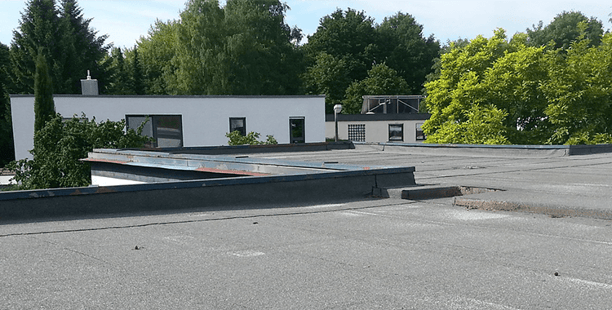
Owning and maintaining a commercial roof is a big responsibility. It can be frustrating and stressful when it springs a leak and you have no idea why or how it happened. Dealing with a leak in the roof can be a nightmare that many of us have experienced in our homes and businesses. If your commercial building springs a leak, the consequences can be costly.
Reasons for a Roof Leak
Knowing the source of your leaky roof is the first step in getting it repaired.
Poor Design
Many flat commercial roofs create areas of standing water due to poor design. Puddled water can put unnecessary weight on your roof: a one-inch deep pool of water weighs more than 5 pounds per square foot of surface area. When you consider how large your commercial roof is, it’s no surprise that puddled water can put a substantial amount of stress on your building. This added pressure can damage your roof, causing it to leak.
Insufficient Drainage
Insufficient drainage is another cause of pooling water on the roof. Standing water will find its way into any cracks or crevices below. To prevent leaks due to poor drainage, be sure that your roof’s drains, gutters, and downspouts are all clear and working properly.
Material Damage
There are two crucial elements to your flat, commercial roof: the membrane, which acts as the cover of your roof, and the flashing, which seals the perimeter of your roof. Damage to either of these vital components can result in leaks.
Membrane Damage
Over time, your roof’s membrane may crack, split, or shrink. These changes in the integrity of the membrane can cause it to leak. The membrane may also be damaged from fallen trees or hail. The membrane is an integral part of your commercial roof, so it is important to inspect it frequently and repair any damage you find.
Flashing Damage
Flashing acts as the protector of the membrane’s edges. It is very common for flashing to expand and contract with changes in temperature, which can cause gapping and leakage. Flashing can also become loose during storms, inhibiting its ability to prevent water seepage. Repairing the flashing on your roof can help prevent a leak from forming.
Improper Sealing
Because various outlets on your roof are susceptible to leakage, they must be properly sealed. Possible points of water infiltration in your roof’s membrane include, but are not limited to
- Pipes
- Drains
- HVAC units
- Vents
- Hot stacks
- Gas lines
Each of these holes in the membrane must be sealed and monitored to prevent your roof from leaking. If these outlets have not been properly sealed, this is likely the source of the problem.
Old Age
Like many aspects of a building, your roof will have to be replaced at some point. Flat roofs typically last approximately 15–20 years before they deteriorate to a point beyond repair.
How to Deal with a Leak
Take All Leaks Seriously
Always take a roof leak seriously, and deal with it as soon as possible. What appears to be a small water problem could end up wreaking havoc on your property. A leaky roof can be a simple, inexpensive repair, or it can become a severe problem that necessitates replacing your entire roof.
Be Prepared
Roofs don’t last forever, so you are bound to encounter this problem at some point. When you do, keep calm. If you take immediate action, your roof should be repairable. The longer you wait, however, the longer your roofing and building materials will be exposed to moisture. A quick response will minimize the damage.
Protect the Space
When you notice a leak, immediately move anything that is vulnerable to water damage, such as furniture, desks, electronics, and wall hangings, out of its path. Then, put down buckets and a tarp or plastic sheeting to protect the floor. You may also need to tape plastic along walls if water is dripping down them. If you have ceiling tiles, remove them from the surrounding area so the water doesn’t spread from tile to tile. This will allow the water to flow directly from the leak in the roof to the bucket. Make sure everyone is aware of the problem, and mark off the area so no one slips and falls.
Pinpoint the Source
You may spot the source of the leak when you remove the ceiling tiles. If you don't, go outside when conditions are safe and take proper precautions when climbing onto the roof. Check gutters, downspouts, and drains to see if anything is clogged or backed up.
Call a Professional
Most commercial roof leaks should be repaired by a roofing professional. Do what you can to minimize the damage, and then call a professional to handle repairs to ensure they’re done right and don’t further damage your roof. Once repairs are complete, continue to have your commercial roof inspected twice every year to keep it in top shape.
For more tips on ways to keep your home in top condition, subscribe to our blog!








Comments